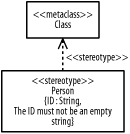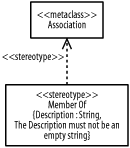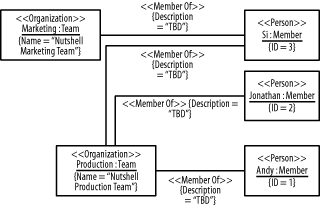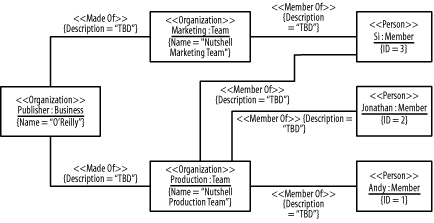B.3 Extension Mechanisms and the Object Constraint Language
The next few sections present solutions for Part IV.
The following describes the figure:
Organization is a stereotype definition that
applies to classes. Made Of is a stereotype definition that applies to
associations. The Organization stereotype has a tag definition
named Name. This is a string that represents the
name of the organization. The Made Of stereotype has a
tag definition named String. This is a string that
describes the relationship between an organization and the things
that make up the organization. The Organization stereotype defines two
constraints indicating that the name of the organization must not be
an empty string, and that the organization must be made of at least
one other thing (any thing). The Made Of stereotype defines a constraint
indicating that the description of the relationship between an
organization and the thing that makes up the organization must not be
an empty string. The following describes the figure:
The Business class is stereotyped as an
organization using the Organization stereotype. The Team class is stereotyped as an organization
using the Organization stereotype. The Business class is associated with the
Team class in which the association is stereotyped
using the Made Of stereotype. The Team class is associated with the
Person class where the association is stereotyped
using the Made Of stereotype. The Person class is not stereotyped. The following describes the figure:
Publisher is an object of the
Business class and is stereotyped using the
Organization stereotype. It has the tagged value
of "O'Reilly" for
its Name tag. Marketing is an object of the
Team class and is stereotyped using the
Organization stereotype. It has the tagged value
of "Nutshell Marketing Team" for
its Name tag. Production is an object of the
Team class and is stereotyped using the
Organization stereotype. It has the tagged value
of "Nutshell Production Team" for
its Name tag. The Marketing object is linked with the
Publisher object in which the link is stereotyped
using the Made Of stereotype. The Production object is linked with the
Publisher object in which the link is stereotyped
using the Made Of stereotype. The Si object is linked with the
Marketing and Production
objects in which the links are stereotyped using the Made
Of stereotype. The Jonathan object is linked with the
Production object in which the link is stereotyped
using the Made Of stereotype. The Andy object is linked with the
Production object in which the link is stereotyped
using the Made Of stereotype. The Description tag of each link that is
stereotyped using the Made Of stereotype has a
tagged value of "TBD" (to be
determined). The following steps show the solution:
Figure B-50 shows the figure.
 Figure B-51 shows the figure.
 The following steps show the solution:
Figure B-52 shows the figure.
 Figure B-53 shows the figure.
 Figure B-54 shows the resulting diagram, which
includes all the steps in this question.
 The following steps show the solution:
Figure B-55 shows the figure.
 Figure B-56 shows the figure.
 Figure B-57 shows the resulting diagram, which
includes all the steps in this question.

The following describes the figure:
The figure captures the relationships among and details about
projects, plans, teams, people, skills, and people's
roles on teams and people's experience with skills
in the project management system. A plan relates to a single project, a single team, and zero or more
people who are human resources of the plan. A project relates to a single plan and relates to a single team. A team relates to a single plan and relates to a single project. A person relates to a single plan. A team relates to zero or more people as members of the team in which
a person plays a role. A person relates to a single team where the
person plays a role. A skill relates to zero or more people and a person relates to zero
or more skills in which the person has experience with the skill. A project has a name that is a string, a start date that is a string,
an end date that is a string, a budget that is a real number, and two
operations to retrieve the start date and end date of the project. A team has a name that is a string. A person has an identification number that is an integer and a name
that is a string. A skill has a name that is a string and a priority that is a string. The relationship between a person and a team defines the title as a
string of the role that the person plays on the team. The relationship between a person and a skill defines the years of
experience as a real number that the person has with the skill. All the attributes and operations are public, but a
project's start and end dates are private. The following describes the rules:
The priority of a skill must be one of the following:
High, Medium, or
Low. The budget of a project must be between 100,000 and 500,000,
inclusive. The name of a team given a role may not be an empty string. The identification number of a person given a role must be greater
than 0 and less than 9999. The identification number of each member of a team must be greater
than 0 and less than 9999. The identification number of each member of a team must be greater
than 0 and less than 9999. The identification number of each human resource who relates to the
plan of a team must be greater than 0 and less than 9999. The following expressions result:
Within the context of a role, the following expression results: self.Title = 'Analyst' or self.Title = 'Architect' self.Title = 'Designer'
or self.Title = 'Developer' or self.Title = 'Tester' or self.Title = 'Manager' The keyword self is optional and the expressions
on either side of the = symbol may be
interchanged, but keep in mind this does not apply to
> or < symbols, and the
expressions on both sides of the or logical
operator may be interchanged. Within the context of experience, the following expression results: self.Years >= 5 The keyword self is optional and the expressions
on either side of the >= symbol may be
interchanged (in which case the >= symbol
becomes the <= symbol). Within the context of a project, the following expression results: self.StartDate = self.plan.StartDate and self.EndDate = self.plan.EndDate Or the following expression results:
self.getStartDate () = self.plan.StartDate and self.getEndDate ( ) = self.plan.EndDate The keyword self is optional and the expressions
on either side of the = symbol may be
interchanged, but keep in mind this does not apply to
> or < symbols, and the
expressions on both sides of the and logical
operator may be interchanged. Notice that the operations to retrieve
the start and end dates of a project may be used but are not
required, because the rule is expressed within the context of a
project. Within the context of a plan, the following expression results: self.StartDate = self.project.getStartDate ( ) and self.EndDate = self.
project.getEndDate ( ) The keyword self is optional and the expressions
on either side of the = symbol may be
interchanged, but keep in mind this does not apply to
> or < symbols, and the
expressions on both sides of the and logical
operator may be interchanged. Notice that the operations to retrieve
the start and end dates of a project are used, because the start and
end date attributes are private in the project and the rule is
expressed within the context of a plan. Within the context of a person, the following expression results: self.team.plan = self.plan The keyword self is optional and the expressions
on both sides of the = symbol may be interchanged,
but keep in mind this does not apply to > or
< symbols. Within the context of a person, the following expression results: self.team.plan = self.plan and self.team.project.plan = self.plan The keyword self is optional and the expressions
on either side of the = symbol may be
interchanged, but keep in mind this does not apply to
> or < symbols, and the
expressions on both sides of the and logical
operator may be interchanged. Within the context of a project, any of the following expressions
results: self.project.plan = self.plan
self.project = self.plan.project
self.project.plan.team = self
self.plan.project.team = self The keyword self is optional in the first two
expressions but is required in the last two expressions following the
= symbol, and the expressions on either side of
the = symbol may be interchanged, but keep in mind
this does not apply to the > or
< symbols.
|